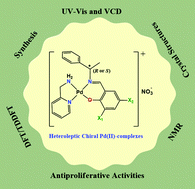Heteroleptic enantiopure Pd(ii)-complexes derived from halogen-substituted Schiff bases and 2-picolylamine: synthesis, experimental and computational characterization and investigation of the influence of chirality and halogen atoms on the anticancer activity†
Abstract
Seven enantiomeric pairs of palladium complexes, [Pd(pic)(R or S)-N-1-(phenyl)ethyl-2,4-X1,X2-salicylaldiminate)]NO3, [Pd(pic)(R or S)]NO3 (X1 = X2 = Cl, Br, I, H; X1/X2 = Br/Cl), were synthesized by the reaction of enantiopure halogen-substituted Schiff bases (R or S)-N-1-(phenyl)ethyl-2,4-X1,X2-salicylaldimine with [Pd(pic)Cl2] (pic = 2-picolylamine). The composition and structure of the complexes were confirmed by means of FT-IR, 1H NMR and 13C NMR spectroscopy, elemental analysis and X-ray crystallography. The electronic structure of the reported complexes was investigated using UV–vis absorption and electronic circular dichroism (ECD) spectroscopy, complemented by DFT/TDDFT modelling. To investigate the effect of chirality and different halogen substituents on the anticancer activity of the complexes, the cytotoxic activity of all fourteen complexes was tested in the human breast cancer cell lines MDA-MB-231 and MCF-7 at 24 h using the colorimetric MTT assay. Also, the cell death mechanism was assessed using the annexin V/propidium iodide (AV/PI) cytometry-based assay.



 Please wait while we load your content...
Please wait while we load your content...